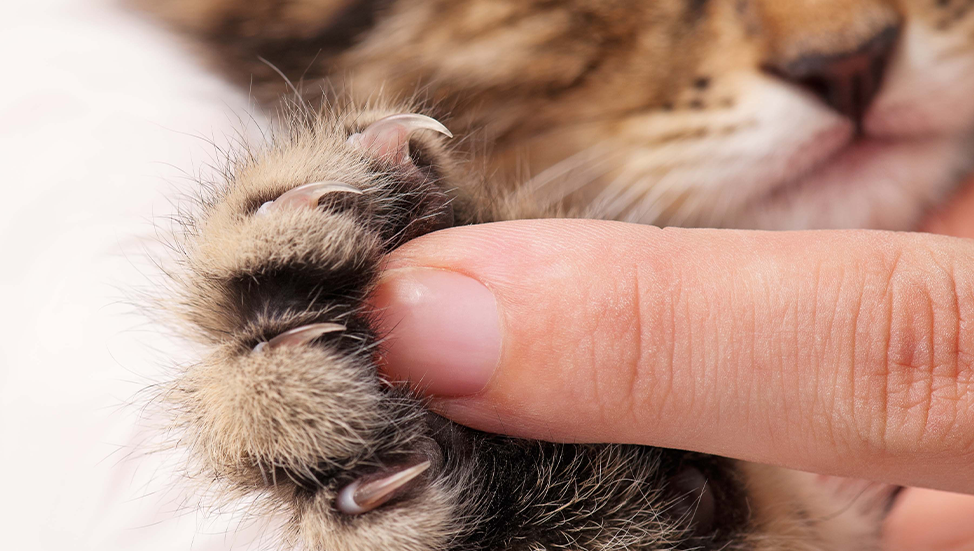Why declawing your cat should be a last resort
Cats can make for nice pets but for many people, all it takes is one scratch to be frightened forever. While declawing cats has been a viable solution to prevent unwanted cat scratches in the past, recent sentiment and research prove just how barbaric and harmful declawing a cat really is.

Many countries and states in the US have banned declawing cats due to the painful and potentially dangerous surgery. Luckily, there are plenty of safe, healthy, and viable alternatives to declawing your cat that can keep you and your cat happy.
Why Do Cats Scratch?
Having your cat scratch is perfectly normal and healthy behavior common to all felines, whether they are small, domesticated house cats or wild and roaming lions. Scratching usually begins when kittens are about eight weeks old. This age is when cats will start to scratch to remove the dead outer shell, called the husk, on their claws. Cats may also use scratching to mark their territory around your home or simply flex and stretch their muscles.
What is Declawing?
Declawing your cat is a process that removes your cat's claws from the paw. Some owners choose only to declaw the front paws, while others decide to eliminate the front and back claws. The process of declawing a cat involves a serious surgery that can adversely affect the cat's health and mobility. New York state was the first state to outlaw this surgery, and many other states have soon followed. Declawing your cat is only allowed in banned states when it is deemed medically necessary. There are three main ways to execute a declawing procedure and all methods for declawing requiring surgery. This surgery is a painful procedure for the cat that should be avoided at all costs.
Amputation
The usual method to declaw a cat is amputation. This method is usually done with a very sharp scalpel or with a clipper called a guillotine clipper. To entirely remove the cat's claw, the entire first jointed bone of the cat paw is removed. This procedure would be the equivalent of cutting off a human finger at the knuckle closest to the nail. The wounds are then stitched, bandaged, and allowed to heal.
Laser
Laser surgery to remove the cat's claw is another technique for declawing your cat. This procedure uses very intense light to vaporize the tissue within the paw. While this seems gentler, the process still requires amputating the first toe bone on your cat's paw.
Tendonectomy
In a tendonectomy, the soft tissues and tendons used to control the cat's claws are severed. In this procedure, the cat can keep his or her claws but simply loses the ability to extend and retract the claws. This procedure can cause the cat's nails to grow thicker than usual, which can introduce a new range of health concerns for your cat.
Medical Concerns with Declawing Your Cat
Aside from being incredibly painful and unnecessary surgery, declawing your cat runs the risk of some pretty severe health complications. When owners remove the claws and first toe bone on a cat, it can permanently change the way they walk. Impacting the cat's gait can lead to discomfort and joint disease. Declawing can also cause arthritis to form in the bones, making it painful to walk, jump, and run.
A cat's claws are a tool and a source of self-defense. Declawing your cat can take away the ability of your cat to defend itself. This inability can be problematic if your cat is left as an outdoor cat or your indoor cat escapes. Declawing can also lead to bone spurs, possible infection, and nerve damage. If your cat has a tendonectomy procedure completed, he or she will have a hard time stretching the muscles and tendons in the legs and paws, which can prevent your cat from staying fit and healthy.
Declawing Alternatives
Understandably, you don't want your furniture to be damaged, and you don't want to suffer painful scratches inflicted by your cat. There are plenty of declawing alternatives to keep your belongings safe and your cat happy and healthy.
- Keep Claws Short: Keeping your cat's claws short is not only more comfortable for your cat, but it is an excellent way to reduce the amount of damage they can inflict on your furniture if they do start to scratch.
- Give Acceptable Scratching Options: Cats by nature need to scratch, so offer your cats a suitable scratching option. Corrugated cardboard ramps and scratching posts are excellent choices. These toys are small, moveable, and relatively inexpensive. Choose different sizes and shapes for scratching posts made of a material like sisal, carpet, and wood to keep your cat interested and engaged.
- Protect Your Furniture: Specially made plastic tape is available to stick to your furniture. The tape is super sticky and helps to deter your cat from scratching. This tape is perfectly safe for cats and your furniture and is an excellent tool to teach young cats what is and isn't acceptable to scratch.
- Plastic Caps: If scratching deterrents are not working for your cat, you may want to try a new product that covers your cat's claws. The soft, plastic caps can be glued onto your cat's nails, offering a solution to potential scratch damaged. The caps must be glued to the nails and need to be replaced every six weeks.
When Is Declawing a Cat Necessary?
Unfortunately, sometimes declawing a cat is medically necessary. Declawing should only be done in extreme situations where no other viable solution is available. A cat may need to be declawed for medical reasons such as a malignant tumor or damaged tissue on the paw. A veterinarian will often only need to declaw one or two toes and not have to remove all the claws on one paw. Some veterinarians may also condone declawing your cat, where legal if there are no other options to house the cat. A cat that is declawed but in a safe and loving home is better than a cat left as a stray.
Ready to start saving money on pet wellness care?
Then take a look at Mint Wellness, the pet wellness plan that provides fast reimbursement on routine pet care. Save on vaccinations, wellness exams, preventatives, dental, and more!
Learn More


